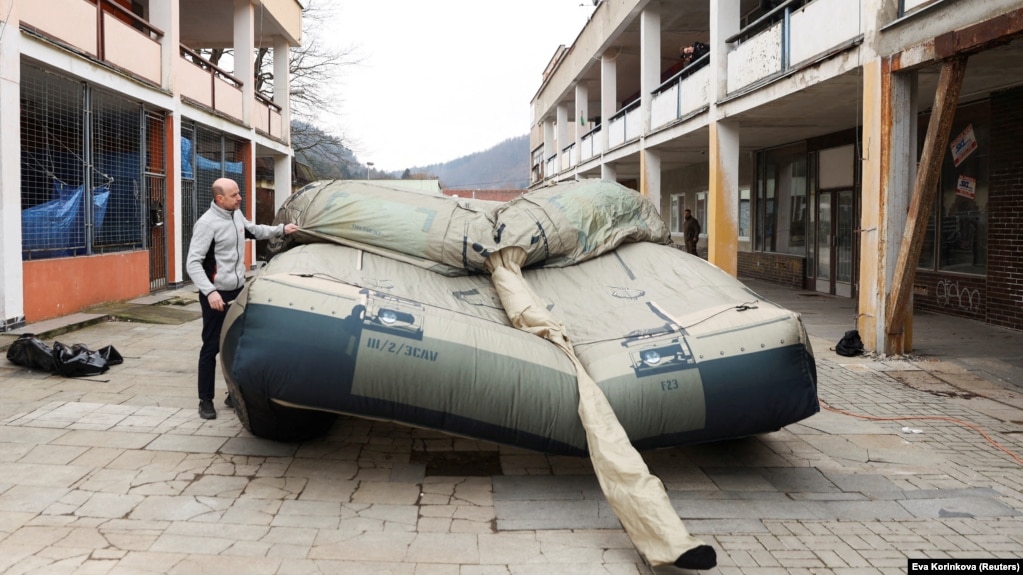Yes, Really!
"I can imagine that if we want to support a partner country which is in trouble, we will send them Inflactech inflatable decoys and they are already there or certainly will be.""If you lead the enemy to destroy my piece of equipment by something that is four, or maybe 20 times more expensive, then you are winning economically."Vojtech Fresser, chief executive, Inflactech Decoys, Decin, Czech Republic
 |
| A worker prepares an inflatable decoy of a military vehicle, which is used to confuse enemy attacks, during a media presentation in Decin, Czech Republic, March 6, 2023. REUTERS/Eva Korinkova |
If given a choice, a military with limited equipment and funding might find it inordinately sensible to make use of inflatable 'decoys' than the far more expensive real instruments of war whose loss can be fundamental to losing or winning a conflict. The loss of a high mobility artillery rocket systems (HIMARS) can be seen as catastrophic to a nation fighting an existential war, but when it's an inflatable version of the system, its loss is regrettable but manageable, since it played the role for which it was intended at far less cost to a strained military equipment situation.
Such a decoy has a dual purpose; to persuade an enemy that the battle they are facing has odds in favour of the defensive military, and secondly that in destroying the decoy in the belief it is authentic, the instrument of its destruction is itself destroyed at a far more steep acquisition cost than that of the decoy. Impoverishing the weapons cache of an aggressor at a far lesser cost to the defense is an obviously desirable goal.
With the requirement to fight an aggressive Russia successfully requiring technologically advanced war materiel; heavy military vehicles, guns and planes, the Czech manufacturer of fake army equipment has seen an uptick in interest in its wares. The company currently has designs for over 30 types of inflatable, real-size decoys that it sells globally, and it has more latterly added HIMARS to its arsenal. Whether Ukraine is in possession of any of these equipment fakes is unknown.
What is known is that the Czech Defence Ministry involved in organizing Czech military supplies to Ukraine, certainly has the freedom and the potential to include among that assortment of supplies, any number of relatively inexpensive, but highly effective, inflatable fakes. Whether it has or intends to is pure speculation, but it seems sensible to have done so.
 |
| A worker prepares an inflatable decoy of a military vehicle during a media presentation in Decin, Czech Republic, on March 6. |
Produced from synthetic silk, the devices have a thermal footprint, appearing on radars to convince enemy reconnaissance that they're authentic. The inflatables fold down into sacks two to four soldiers can carry. Inflation time is no longer than ten minutes. Without the heat generator and compressor equipment, the HIMARS inflatable top alone weighs 43 kilograms. The cost of the decoys ranges from $10,000 to $100,000.
Business for this industry whose factory is located in the Czech north has grown in the past year following the February 2022 invasion by Russia into Ukraine. There are as-yet unconfirmed reports that the Russian military has been wasting its artillery on the destruction of such decoys employed by Ukraine, accounting in part for its shortages; a costly and useless waste of expensive ammunition in a clever strategy to outfox and outmaneuver the enemy.
 |
| An inflatable decoy of an M1 Abrams tank is displayed during a media presentation in Decin, Czech Getty |
Labels: Defence, Faux Military Equipment, Inflatable Weaponry Fakes, Russian Invasion of Ukraine, Ukrainian Military

0 Comments:
Post a Comment
<< Home